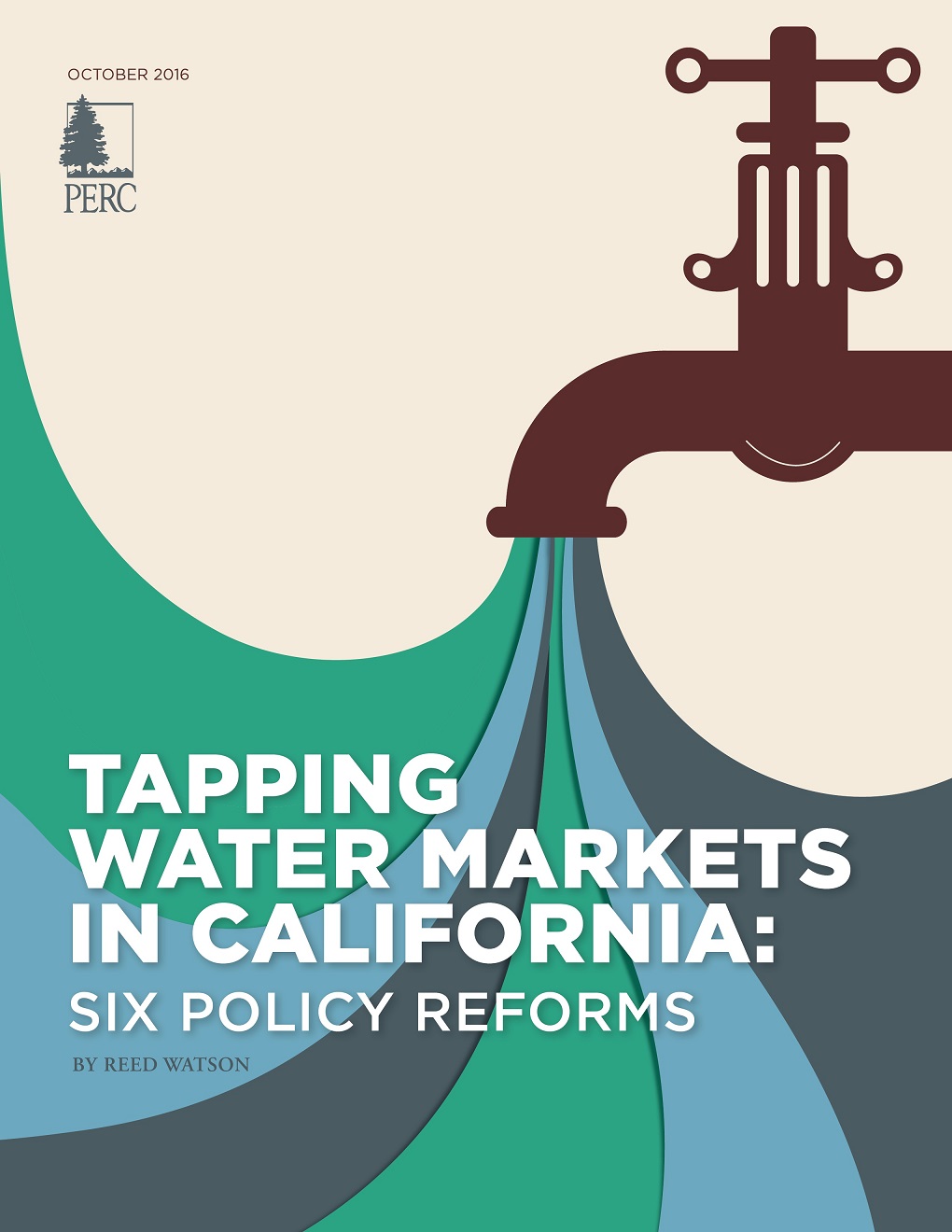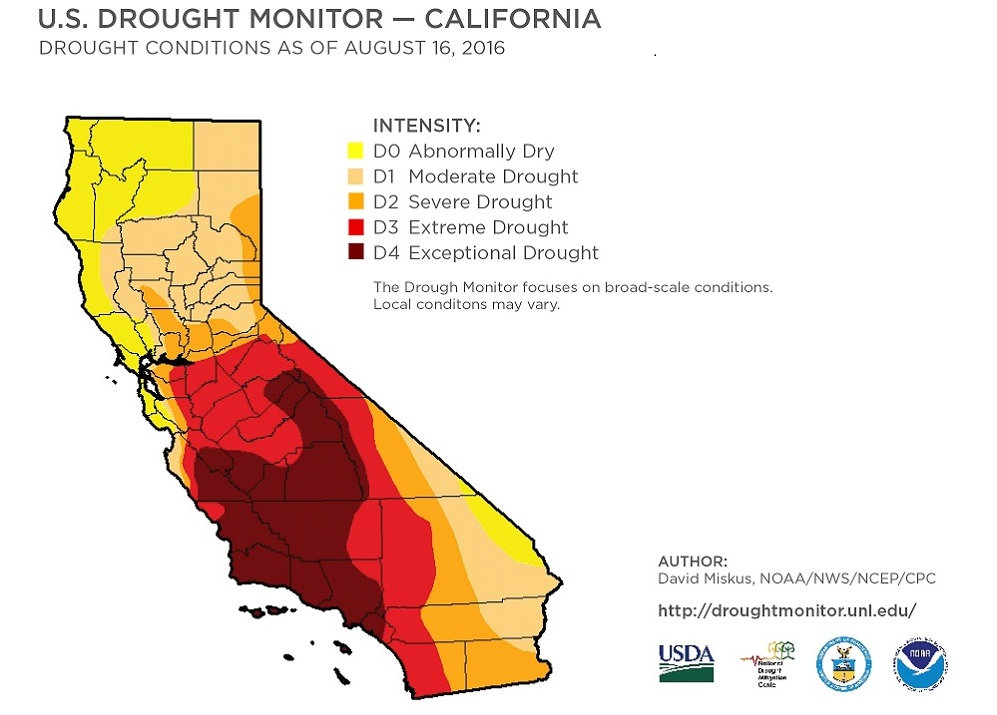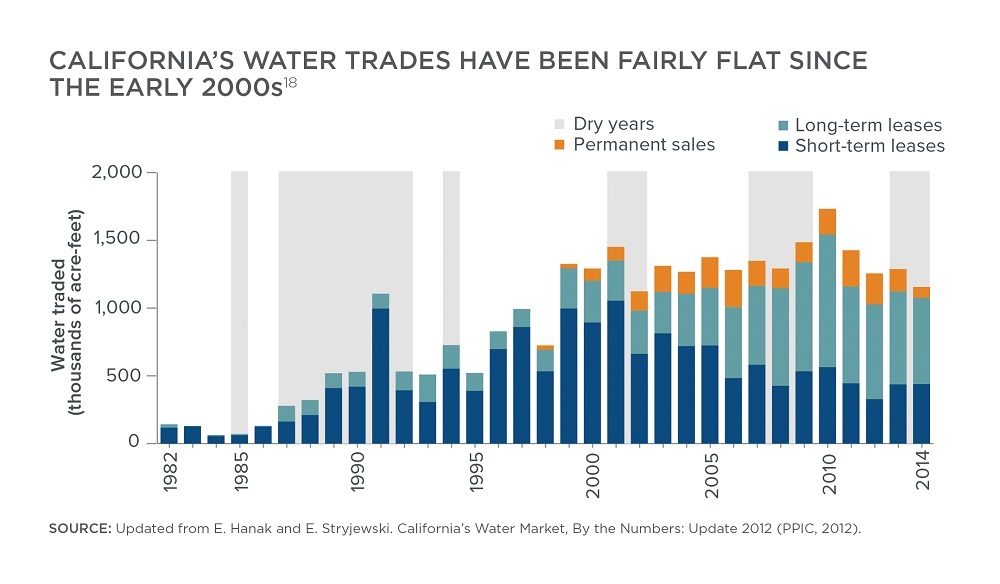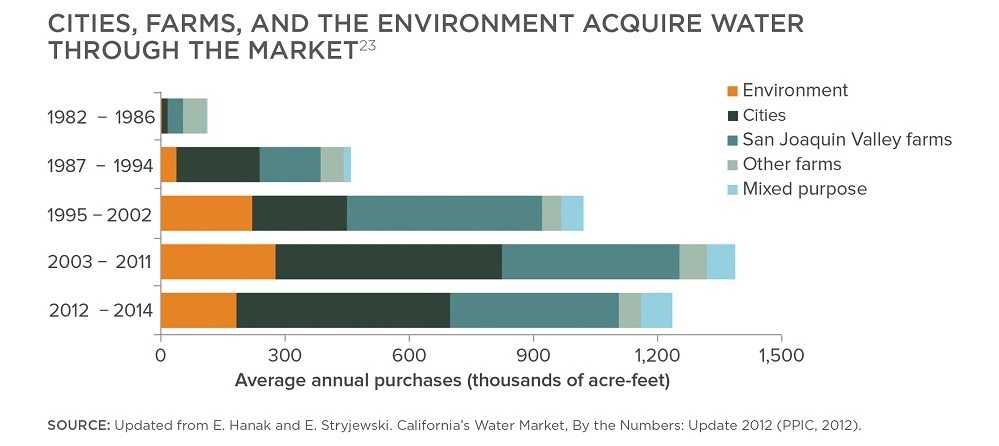DOWNLOAD THE FULL REPORT
Summary
Water is a scarce and contentious resource in California. The prolonged drought still gripping the state has revealed just how important water is to the state’s economy and its environment. The drought has also revealed how California’s water laws and regulatory procedures can discourage conservation and limit flexibility.
Media coverage of the drought has portrayed water scarcity as a new and temporary phenomenon in California. It is not. For decades, water supplies have been insufficient to satisfy all of California’s growing demands. With the state’s population projected to increase from 38 million today to 44 million by 2030, water scarcity will remain a fact of life in California regardless of short-term precipitation. The question is: How can California allocate water in the most economically productive and environmentally sensitive way?
This report offers an answer: water markets. Markets allow competing water users to cooperate rather than fight over scarce water resources. By encouraging water conservation and facilitating trades, California can alleviate the economic and environmental effects of water scarcity, in both the short term and the long term.
The policy reforms advanced in this report are relatively subtle, and that is by design. Previous efforts to overhaul California’s water allocation system have failed, in part, because they would have disrupted settled expectations and favored certain uses only at the expense of others. Fortunately, even minor modifications would go a long way toward fostering mutually beneficial water trades. The critical challenge is to encourage water marketing in ways that do not jeopardize the rights of other water users or the quality of California’s environment.
To meet that challenge, PERC conducted a multi-year study of water management in California. We hosted two separate workshops for water users, policy experts, government officials, and conservationists to identify the most significant barriers to water trading and the most feasible strategies for overcoming those barriers. We then conducted an extensive online survey to vet the proposed policy reforms for their efficacy and political feasibility.
The results of those efforts are described below. These policy proposals will not magically increase water supplies in the Golden State, but they do offer a reasonable starting point for tapping water markets to make the most of California’s scarce water resources.
Key Points
- By law, proposed water transfers must be carefully reviewed to ensure they do not take water from other rights holders or the environment, the so-called “no injury rule.” However, the current review process often discourages socially and environmentally beneficial water transfers.
- Streamlining the review process for transfers previously approved by the State Water Resources Control Board and those that preserve or enhance wetlands habitat, fish and wildlife resources, or recreation would encourage beneficial water transfers without eroding the rights of other water users or the environment.
- Conducting comprehensive basin-level environmental reviews of multiple transfers occurring within the same geographic area or time frame would similarly remove bureaucratic red tape and encourage water conservation and trading.
- Storing water underground can be an effective way to smooth consumption across years of inconsistent precipitation. Relatively subtle changes to the state’s water laws are needed to unlock the full potential of groundwater banking.
- California’s water laws are highly complex, and the resolution of water disputes is consequently slow and unpredictable. Directing water cases to judges with water expertise would accelerate and improve the resolution of those disputes.
Introduction
The California drought reached epic proportions in 2015, and the situation has barely improved this year. More than half the state is still plagued by “severe drought,” as defined by the U.S. Drought Monitor scale.1 In terms of precipitation, the three years between 2011 and 2014 were the driest on record.2 Snowfall during the 2014-15 winter totaled a meager 5 percent of the annual average, making it the driest winter in the state’s recorded history.3 Last winter’s snowfall, which benefitted from an El Niño cycle, still fell short of the long-term average, topping out at 87 percent of that average threshold in the Sierra-Nevada.
The lack of moisture has wreaked havoc on the state’s economy, with the agriculture industry hardest hit. Economists at U.C. Davis estimated the 2015 agricultural impacts at $900 million in lost crop revenues, $590 million in increased groundwater pumping costs, and $350 million in lost livestock and dairy revenues.4 California farmers, most of them in the Central Valley, fallowed more than 540,000 acres, resulting in the loss of more than 10,000 seasonal jobs.5 According to the U.S. Drought Monitor, nearly all of the state’s 38 million residents have been affected in some way by the current drought.6
The environmental toll is similarly devastating. Without sufficient stream flows, some fish populations around the state have plummeted.7 A report by the Public Policy Institute of California noted that if dry and hot conditions persist for several more years, 18 native fish species could face a high-risk of extinction.8 The dwindling water supplies pit conservationists against Central Valley farmers and Southern California cities in a zero-sum fight for an increasingly scarce resource. Meanwhile, the exceptionally dry conditions have increased the number and severity of wildfires, with nearly 40 percent more wildfires recorded in 2015 compared to the previous five-year average.9
In response, California’s government has aimed to reduce water consumption, primarily through use restrictions. On April 1, 2015, Governor Jerry Brown issued an executive order requiring the State Water Resources Control Board (Water Board) to impose restrictions that would force cities and towns across the state to reduce potable water consumption by 25 percent.10 And in 2015, the Water Board ordered certain rights holders to stop diverting water for the first time in nearly four decades.11
The severity and duration of the current drought have dominated headlines, but water scarcity is nothing new for California. For decades, water demands have outstripped available supplies. Between 1990 and 2014, for instance, Central Valley Project contractors south of the Sacramento-San Joaquin Delta received their full annual allotment only three times. During the other 12 years, below-average precipitation and court-ordered diversions for endangered fish habitat combined to reduce deliveries below allotment levels—often drastically below. Similarly, during the same time period, State Water Project contractors received their full contracted supplies in just six of 15 years.12
With a rapidly growing population, regional variation in water availability, and legal institutions that tend to encourage litigation, water will continue to be a contentious issue in California even if precipitation levels return to “normal.
How can California allocate its scarce water resources in the most economically positive and environmentally sensitive manner?
The question now facing California is: How can the state allocate its scarce water resources in the most economically productive and environmentally sensitive manner? Allocating water through the political process—the status quo—presents several challenges. First, regulators and elected officials lack the information to know where and when water is most needed. Second, whenever the political or regulatory process reallocates water, it does so involuntarily, creating winners, losers, and protracted court battles. Third, the complexity of the state’s water laws discourages voluntary, socially beneficial trades from occurring. Taken together, the political process of allocating water in California typically leads to inefficient, acrimonious, and inflexible results.
Use restrictions and political reallocations will not fix California’s water woes. Consider the Sacramento-San Joaquin Delta which, despite years of litigation and political maneuvering, fails to meet either of the competing demands placed on it: reliable flows for endangered fish or reliable water conveyance for Central Valley farmers and Southern California cities.13 Without innovative reforms, this “nobody wins” outcome in the Delta will become the norm statewide.
What California needs is a system for allocating water that operates efficiently, fosters cooperation rather than conflict, and creates flexibility between competing water uses. In other words, what California needs is water marketing.
Tapping Water Markets
Rarely does one hear of shortages in tennis shoes, automobiles, or computers. Why? Because markets for these goods work to eliminate shortages by balancing demand and supply. Market prices convey important information about the scarcity of goods that both consumers and producers use to adjust their behavior: Increasing prices reflect scarcity, encouraging producers to supply more and consumers to demand less. Falling prices reflect abundance, encouraging producers to supply less and consumers to demand more.
The water crisis in California has persisted largely because prices in many parts of the state fail to reflect the scarcity of the resource. Consider the city of Folsom, 20 miles east of Sacramento. Until 2011, the city charged homeowners a flat monthly fee of $35 for water service, no matter how much water they used. Folsom residents used a daily average of 429 gallons per person in 2014—one of the highest consumption rates in the state. By comparison, residents in neighboring Sacramento averaged 279 gallons per day.14 The difference? Sacramento uses meters to measure each household’s water use and charges more for consuming more.
Where water use is billed by volume, the prices often convey incomplete and inaccurate information: Water subsidies artificially lower the price for certain uses while regulations and transfer restrictions preclude other uses. Take the Sacramento-San Joaquin Delta as an example. The Endangered Species Act effectively prohibits any use of water that harms a listed species, such as the Delta smelt or winter-run Chinook salmon; meanwhile, the federally managed Central Valley Project pumps and subsidizes Delta water to farms. These conflicting regulations and price distortions, coupled with the historically entrenched “use it or lose it” rule of California water law, effectively discourage conservation and prevent water from flowing to its highest valued use.15
Despite the price-distorting subsidies and regulatory red tape, some Californians are harnessing markets to minimize the economic and environmental costs of water scarcity. One example is the Scott River Water Trust in Siskiyou County, which pays farmers to leave water in-stream for salmon and steelhead during dry periods. These water leases typically last 30 to 90 days, after which farmers can again divert water for irrigation or stock water. The leasing farmers make money and maintain their water rights, while fish and wildlife in the Scott River watershed get a much-needed drink.
Whether an informal agreement between ranching families or an inter-basin transfer of enormous volumes across the state, voluntary transfers move water from lower- to higher-valued uses, the definition of efficiency. Water contracts are flexible and can be tailored to meet the specific needs of a farm, a stream, or a city. They can be structured as temporary leases that last anywhere from a few hours to several years, or they can be outright sales that transfer water rights permanently. The ability to transfer rights also provides a buffer during temporary drought conditions and accommodates longer-term changes in patterns of demand.
Currently, water transfers constitute only 3 percent of all water used annually by California’s businesses and residents.17Due primarily to infrastructure and institutional constraints, the volume of water transferred has stayed relatively constant during the last decade, even as the drought intensified. To replicate the Scott River Water Trust model statewide and reap the benefits of efficiency, cooperation, and flexibility that water markets provide, California must change the rules of the game to encourage voluntary transfers. A few common-sense policy reforms would make a big difference.
Scott River WatershedFrom 2008 to 2011, water leases improved more than 50 miles of spawning habitat in the Scott River watershed for Coho salmon, improving the number of adult salmon fivefold. At the same time, the leases avoided the expensive and acrimonious court battles that often characterize allocations to instream flows.16 |
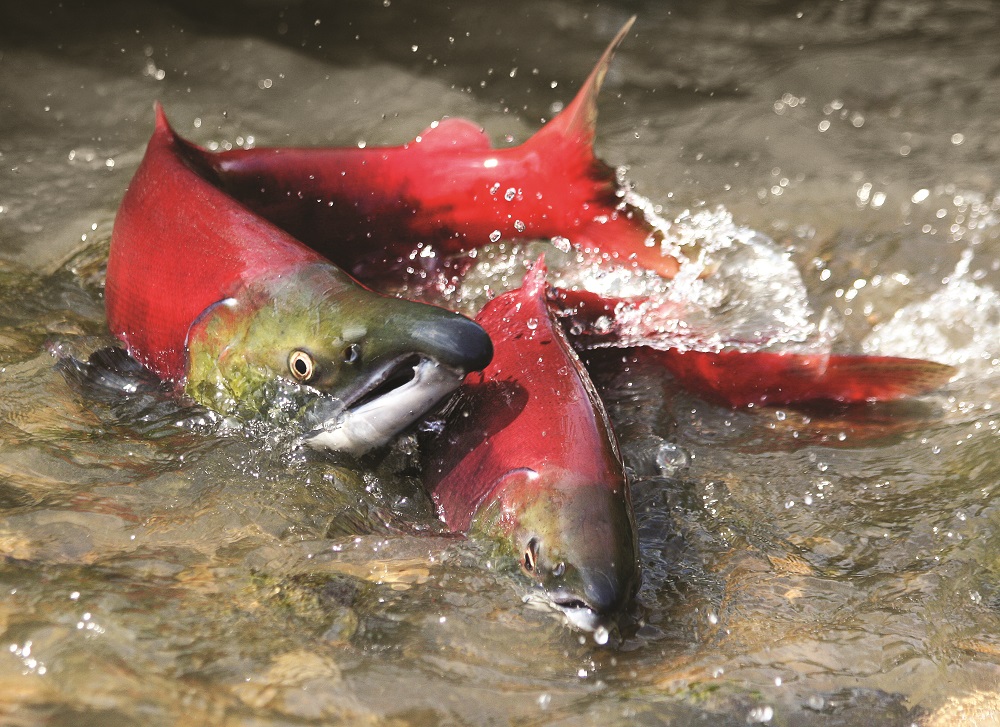 |
Policy Reforms
The Property and Environment Research Center (PERC) engaged in a multi-year research initiative to identify the barriers to water marketing in California and develop effective and politically feasible strategies for overcoming those barriers. We held two workshops in California that brought together water users, policy experts, government officials, conservationists, and scholars. Participants provided insights into possible ways to reform California’s complicated water laws, with the goal of those reforms to facilitate water transfers that benefit the state’s economy and environment.
Following the workshops, we circulated the policy reform concepts to water users and experts across the state and used an online survey to solicit feedback from them. The survey and workshop participants presented insightful discussion and often opposing opinions regarding water allocation. By no means was there universal agreement among such a diverse group of practitioners and users when it came to policy recommendations. However, all participants agreed that water management in California has plenty of room for improvement, and the process informed PERC’s analysis of water marketing in the state.
The policy reforms outlined below were those supported by a majority of the participants and fall into four categories: transfer approval, environmental review, aquifer storage, and dispute resolution. These proposals do not reflect the views of every workshop participant or survey respondent.
Six Policy ReformsTransfer Approval1. Streamline the administrative review of transfers previously approved by the Water Board if they were implemented without adverse impacts to other water users or the environment. 2. Streamline the review process for short-term transfers that preserve or enhance wetlands habitat, fish and wildlife resources, or recreation. Environmental Review3. Conduct a comprehensive basin-level environmental review instead of individual reviews for water transfers occurring within the same goegpraphic area or time frame. 4. Minimize the environmental review requirements for water transfers specifically initiated to enhance environmental resources. Aquifer Storage5. Modify the water code to expictly include underground storage as a beneficial use. Dispute Resolution6. Delegate authority over water disputes to specific court-appointed water law experts. |
Transfer Approval
In California, the State Water Resources Control Board must approve any change to a water right. This includes a change in use related to a water lease or purchase. Permit applicants are subject to a 30-day public notice period, a 45-day administrative review period and, depending on the duration of the proposed transfer, a months- or years-long environmental review.19 Protests then require additional time to resolve any conflicts, while permit applicants bear the burden of proof to ensure the transfer will not damage another water user or the environment.
These delays can undermine the original motivation for the transfer if the purchaser’s or lessor’s demand is seasonal or short-term. They can also add significant costs to water trading, so much so that the benefits of a transfer may be completely wiped out. In some cases, wading through cumbersome bureaucracy and legal appeals can cost more than the water itself, proving to be an insurmountable barrier for all but the biggest and most lucrative water deals. For instance, it took the Scott River Water Trust two years and $30,000 to obtain a water right and dedicate it to an environmental purpose through the state’s water rights transfer process.20
Participants at both workshops identified the administrative review process as a significant source of cost and delay for water marketing. Discussions centered on how to address unnecessarily burdensome review procedures. In particular, participants agreed that two types of water transfers are good candidates for expedited review by the Water Board, as they are less likely to impair the rights of other users or have negative environmental impacts: renewal transfers that have been previously reviewed and approved, and short-term transfers for environmental purposes.
Reform No. 1
Streamline the administrative review of transfers previously approved by the Water Board if they were implemented without adverse impacts to other water users or the environment.
The process should be simpler because the experience with the previous transfer helps demonstrate the lack of injury or environmental harm.
— Workshop Participant
Actions
- Shorten the public comment/objection period. Allow a maximum of 15 days for potential objectors to come forth with questions or comments about a previously approved transfer. Any substantive issues with the transfer would likely have surfaced during the Water Board’s initial review, which means additional time for public comment adds unnecessary delay.21
- Shorten the review period by state agency staff. The Water Board currently has 45 days to issue a decision on a transfer application.22 This review period could be shortened to 7 days if no comments are received or 15 days if they are. A previously approved project would have already undergone extensive review by resource experts during its initial application to the agency.
- Allow for an appeals process in case conditions have changed, but shift the burden of proof to the party claiming injury. The first time a transfer is reviewed by the Water Board, the applicant has to bear the burden of proving that the project will not harm any other water user or the environment. If the same conditions apply for a project’s renewal, it should fall to the objector to prove how the transfer may affect their water use or the resource.
Considerations
- If a transfer undergoes multiple renewals, the environmental analysis may need to be updated every five to 10 years to ensure new conditions are accounted for and will not impact environmental resources.
- Some applicants may try to abuse the system by applying for multiple one-year transfer renewals to sidestep the scrutiny associated with a longer-term transfer. This abuse could be prevented by limiting the number of one-year water transfer renewals allowed per project.
Reform No. 2
Streamline the review process for short-term transfers that preserve or enhance wetlands habitat, fish and wildlife resources, or recreation.
If the transferred water is left in-stream, the Water Board review should be minimal, unless the transfer involves a change in the point of diversion or the water is transferred out of the basin.
— Workshop Participant
Actions
- Allow provisional approval while the transfer is reviewed, particularly if fish and wildlife agencies testify to the natural resource need. Environmental water transfers are usually aimed at getting more water in a certain stream reach during a very specific time frame. If the transfer is bogged down in review criteria or appeals processes, the fish and wildlife that depend upon that water will suffer. Provisional approval would keep streams wet after a brief initial review that determines the transfer would cause no injury to other users.
- Change the burden of evidence from the party making the transfer to the party claiming injury. Typically, the party applying for a transfer bears the burden of proving the project will not injure other users or the environment. However, fish, wildlife, and other natural resources are owned by the State of California and held in trust for the benefit of its residents. Water transfers that improve these communal resources should get a leg up during an appeals process by shifting the burden of evidence to the parties that object to the environmental improvement.
- Provide criteria that distinguish between small in-basin transfers versus large out-of-basin transfers. If a project proposes to move a large amount of water into a completely different basin, it will likely have much more complex impacts than a small project that only moves water within the same watershed. The complex project deserves a more extensive review. One way to differentiate review criteria could be to set a threshold on the amount of water. For instance, if a project would transfer more than 100 acre-feet of water or transfer water out of a basin, then it would qualify for a more rigorous review.
Environmental Review
Most water transfers have to undergo a lengthy and expensive review pursuant to both the California Environmental Quality Act (CEQA) and the National Environmental Policy Act (NEPA).24 While important for protecting California’s natural resources, these analyses often preclude smaller transfers, environmental transfers, or multiple transfers in a single geographic area. A more comprehensive approach could reduce unnecessary expenses and move water more quickly without sacrificing environmental protections.
Workshop participants had several ideas for how to reduce the transaction costs associated with these environmental reviews. For instance, agencies could conduct a programmatic review of the environmental impacts associated with water transfers across a certain watershed or service area. A basin-scale CEQA and NEPA analysis would examine the impacts of a set of water transfers collectively, rather than taking the less efficient “one at a time” approach. If the agencies deem transfers to be non-injurious as a whole, each specific application could then be reviewed quickly using the comprehensive analysis.
Jay Lund, co-author of a Public Policy Institute of California report on water markets, calls the existing system “administratively awkward.”25 The main complaint is the amount of time that it takes to complete a transfer. Lund notes that the review process alone can take an entire season—not necessarily helpful as farmers have to pull water from rivers when they are flowing. Mike Wade of the California Farm Water Coalition echoes Lund’s complaints, stating that “instead of responding to immediate needs, transfers have become planning tools for future demand.” Richard Howitt, co-author of the PPIC report, sums up the current situation with California water markets, saying, “it’s just too time-consuming and expensive, so that a lot of people don’t even bother.”
Reform No. 3
Conduct a comprehensive basin-level environmental review instead of individual reviews for water transfers occurring within the same geographic area or time frame.
It is a far better use of regulatory assets for reviews to consider the large picture, not the small.
— Workshop Participant
Actions
- Encourage the Department of Fish and Wildlife and the Department of Water Resources to conduct a programmatic environmental impact review (EIR) for transfers within a specified geographic area, hydrologic zone, or conveyance system. Agencies would analyze the impacts of a certain type of transfer (e.g., from agricultural to in-stream use) within a specific area. Once the comprehensive environmental analysis was complete, individual transfers would undergo a streamlined review process to ensure they met requirements laid out in the EIR. When deciding how or when to use a comprehensive review instead of an individual review, criteria could include: limits on the volume of water transferred, specified timing for when the transfers occur, or a threshold for the cumulative total of water eligible for transfer within a region.
- Pilot a programmatic CEQA and NEPA review in an area where water marketing is active. Testing innovative ideas could lead to better ways to distribute scarce resources, especially when it comes to contentious water resources. Agencies could first focus on completing a large-scale environmental analysis of the impacts of water transfers in a region where several water transfers are already occurring. Potential locations include the Sacramento Valley, San Francisco Bay Area, or Colorado River service areas.
Consideration
- A broader review may prove scientifically complicated in certain geographic areas where unique geologic or hydrologic conditions exist.
Reform No. 4
Minimize the environmental review requirements for water transfers specifically initiated to enhance environmental resources.
Land-based conservation easements are already exempt from CEQA. It makes sense to expand this exemption to in-stream water transfers, too.
— Workshop Participant
Action
- Exempt transfers made under §1707 from environmental review, since they preserve or enhance wetland habitat, fish and wildlife resources, or recreation. Transfers under §1707 are specifically designed to improve rather than harm the environment. An exemption for environmental flow transfers would save time and money and expedite the process of transferring water to fish and wildlife in need. Plus, state law already requires that any transfer prove it will not injure any other water user, including the environment. NEPA and CEQA reviews are likely redundant for water transfers that dedicate water instream and enhance environmental flows.
Consideration
- State law already encourages the consolidation of the CEQA and NEPA processes into a single environmental review for water rights dedicated to enhancing wetlands habitat, fish and wildlife resources, or recreation.
Aquifer Storage
Storing water underground during wet years for extraction and use during dry years is a common-sense way of banking water for California’s future. Groundwater banking acts as a safety for providing freshwater in the face of climate variations. In fact, California’s 515 groundwater basins hold at least three times as much usable water as the state’s man-made reservoirs.26
Unfortunately, California law is unclear as to whether groundwater storage—also known as aquifer recharge—is considered a valid beneficial use of water if the party storing the water does not explicitly identify the ultimate purpose and place of use.27 This uncertainty discourages potentially beneficial water trades and storage projects in years with above average precipitation.
Reform No. 5
Modify the water code to explicitly include underground storage as a beneficial use.
There is no economic justification for preventing users from storing water.
— Workshop Participant
Action
- Explicitly add aquifer recharge as a beneficial use of surface water via legislative action. California water laws recognize certain uses of water as “beneficial,” including agricultural, municipal, industrial, and environmental uses. Water rights are specific to a certain type of use, and right holders are only allowed to use water for legally designated beneficial uses. That means that it may currently be illegal to transfer a water right for the purpose of storing water underground, which is clearly an impediment for applying water marketing tools to beneficial groundwater projects.
Dispute Resolution
Water right transfers often involve complex and protracted legal issues. During the review process, an objector might have concerns over potential impacts to his or her rights. For example, if a portion of an irrigator’s diversion returns to the river from which it was diverted, other users downstream might rely on that return flow to fulfill their diversions. Thus, a transfer of the entire diversion listed in the water right would harm downstream rights holders; only the consumptive use portion can be transferred. The Water Board is the first step in resolving conflicts over water transfers and their potential impacts on other rights holders or the environment. If the parties disagree with the Board’s ruling, however, they can appeal the decision to one of California’s 58 Superior Courts.
Most municipal or superior court judges aren’t well versed in California’s complex set of water laws, which creates yet another bottleneck that blocks water transfers. Workshop participants brought up the idea of designating specific water experts or local superior court judges to hear cases. If disputes were heard by mediators experienced in water rights issues, it would likely significantly reduce the cost, delay, and uncertainty associated with litigating water transfers.
Reform No. 6
Delegate authority over water disputes to specific court-appointed water law experts.
This option is intriguing, as a special master does not have to be an expensive attorney and would have field experience with actual water rights.
— Workshop Participant
Actions
- Refer all appealed cases involving water transfers in a specific county or watershed to a local judge who is adept at navigating water law. Water law is extremely complicated. Rather than expecting every judge to learn the nuances of managing water rights if a case comes up, it makes sense to assign one local judge to cover this specialized legal topic. Using experienced judges will reduce the time spent in court – and less time means fewer legal bills and more water where it’s needed.
- Utilize court-appointed special masters with water rights management experience to hear disputes and recommend resolution. Special masters are people who deal with water rights day in and day out, turning on and off diversions or allocating water within a service area. These are the best people to mediate problems between water users. While special masters might not issue final decisions, they could make recommendations to courts after fact-finding investigations between parties. California already approaches CEQA cases in a similar way, recognizing that it saves time and money to designate specialized experts to resolve complicated environmental disputes.
Consideration
- It may take additional funding to pay designated water judges or special masters. This cost could be paid by the parties litigating a water right case.
Conclusion
Water marketing is a common-sense and cost-effective option for meeting California’s growing and changing demands for water. Contracts like leases that move water rights between low- and higher-value uses are important tools for reallocating water in a state where cities are growing, crops are thirsty, and fish are suffering from dwindling stream flows.
Unfortunately, transferring water between uses is not an efficient solution under California’s current legal and administrative framework. Institutional barriers and bureaucratic hurdles tend to hamstring water entrepreneurs looking to meet site-specific needs around the state. But with a few key policy reforms, California could be well on its way to market-based contracts that transfer water to where it’s needed most.
Download the full report, including endnotes and references.
